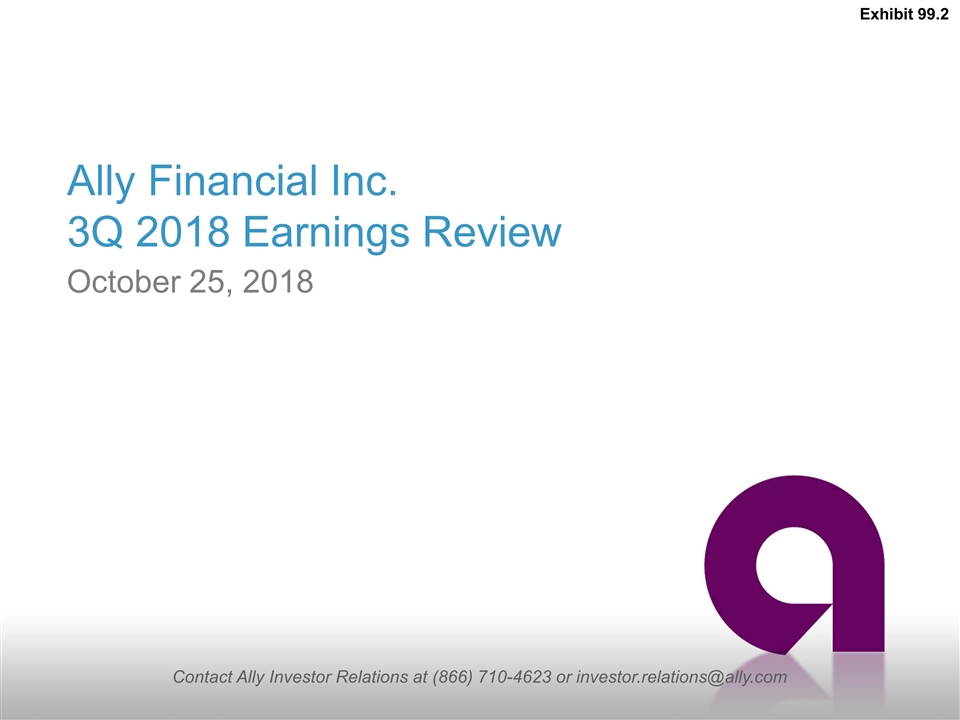
Ally Financial Inc. 3Q 2018 Earnings Review Contact Ally Investor Relations at (866) 710-4623 or investor.relations@ally.com October 25, 2018 Exhibit 99.2
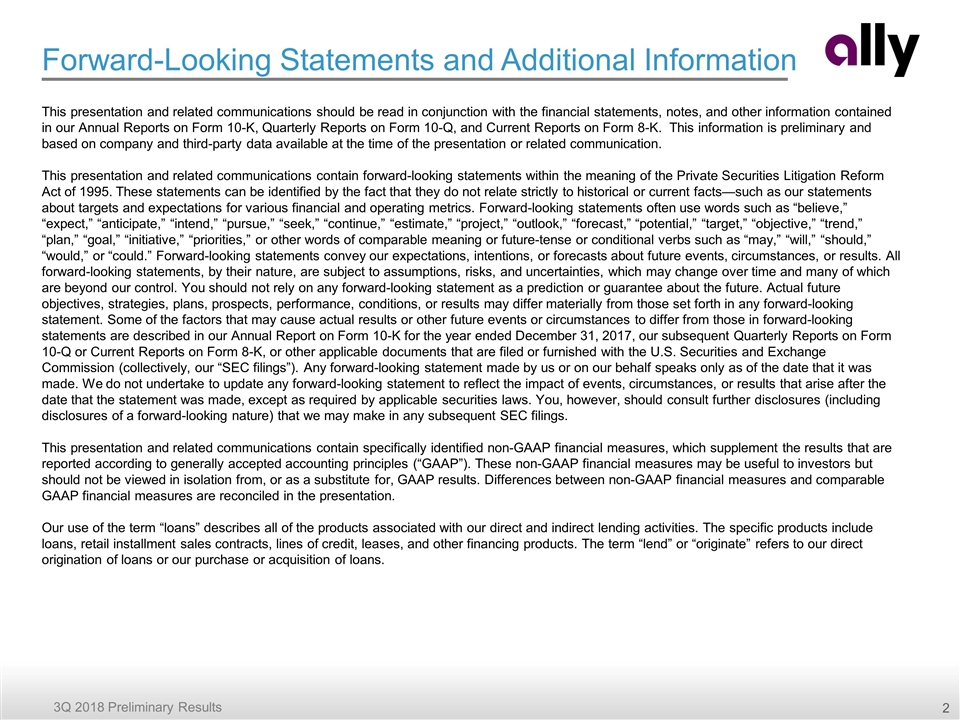
Forward-Looking Statements and Additional Information This presentation and related communications should be read in conjunction with the financial statements, notes, and other information contained in our Annual Reports on Form 10-K, Quarterly Reports on Form 10-Q, and Current Reports on Form 8-K. This information is preliminary and based on company and third-party data available at the time of the presentation or related communication. This presentation and related communications contain forward-looking statements within the meaning of the Private Securities Litigation Reform Act of 1995. These statements can be identified by the fact that they do not relate strictly to historical or current facts—such as our statements about targets and expectations for various financial and operating metrics. Forward-looking statements often use words such as “believe,” “expect,” “anticipate,” “intend,” “pursue,” “seek,” “continue,” “estimate,” “project,” “outlook,” “forecast,” “potential,” “target,” “objective,” “trend,” “plan,” “goal,” “initiative,” “priorities,” or other words of comparable meaning or future-tense or conditional verbs such as “may,” “will,” “should,” “would,” or “could.” Forward-looking statements convey our expectations, intentions, or forecasts about future events, circumstances, or results. All forward-looking statements, by their nature, are subject to assumptions, risks, and uncertainties, which may change over time and many of which are beyond our control. You should not rely on any forward-looking statement as a prediction or guarantee about the future. Actual future objectives, strategies, plans, prospects, performance, conditions, or results may differ materially from those set forth in any forward-looking statement. Some of the factors that may cause actual results or other future events or circumstances to differ from those in forward-looking statements are described in our Annual Report on Form 10-K for the year ended December 31, 2017, our subsequent Quarterly Reports on Form 10-Q or Current Reports on Form 8-K, or other applicable documents that are filed or furnished with the U.S. Securities and Exchange Commission (collectively, our “SEC filings”). Any forward-looking statement made by us or on our behalf speaks only as of the date that it was made. We do not undertake to update any forward-looking statement to reflect the impact of events, circumstances, or results that arise after the date that the statement was made, except as required by applicable securities laws. You, however, should consult further disclosures (including disclosures of a forward-looking nature) that we may make in any subsequent SEC filings. This presentation and related communications contain specifically identified non-GAAP financial measures, which supplement the results that are reported according to generally accepted accounting principles (“GAAP”). These non-GAAP financial measures may be useful to investors but should not be viewed in isolation from, or as a substitute for, GAAP results. Differences between non-GAAP financial measures and comparable GAAP financial measures are reconciled in the presentation. Our use of the term “loans” describes all of the products associated with our direct and indirect lending activities. The specific products include loans, retail installment sales contracts, lines of credit, leases, and other financing products. The term “lend” or “originate” refers to our direct origination of loans or our purchase or acquisition of loans.
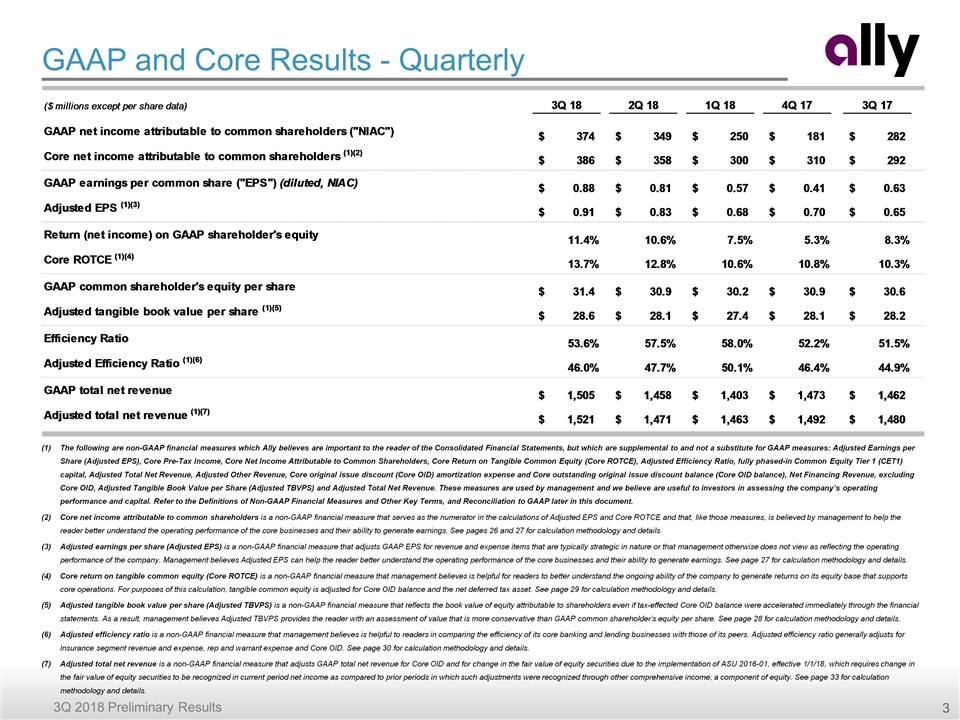
GAAP and Core Results - Quarterly The following are non-GAAP financial measures which Ally believes are important to the reader of the Consolidated Financial Statements, but which are supplemental to and not a substitute for GAAP measures: Adjusted Earnings per Share (Adjusted EPS), Core Pre-Tax Income, Core Net Income Attributable to Common Shareholders, Core Return on Tangible Common Equity (Core ROTCE), Adjusted Efficiency Ratio, fully phased-in Common Equity Tier 1 (CET1) capital, Adjusted Total Net Revenue, Adjusted Other Revenue, Core original issue discount (Core OID) amortization expense and Core outstanding original issue discount balance (Core OID balance), Net Financing Revenue, excluding Core OID, Adjusted Tangible Book Value per Share (Adjusted TBVPS) and Adjusted Total Net Revenue. These measures are used by management and we believe are useful to investors in assessing the company’s operating performance and capital. Refer to the Definitions of Non-GAAP Financial Measures and Other Key Terms, and Reconciliation to GAAP later in this document. Core net income attributable to common shareholders is a non-GAAP financial measure that serves as the numerator in the calculations of Adjusted EPS and Core ROTCE and that, like those measures, is believed by management to help the reader better understand the operating performance of the core businesses and their ability to generate earnings. See pages 26 and 27 for calculation methodology and details. Adjusted earnings per share (Adjusted EPS) is a non-GAAP financial measure that adjusts GAAP EPS for revenue and expense items that are typically strategic in nature or that management otherwise does not view as reflecting the operating performance of the company. Management believes Adjusted EPS can help the reader better understand the operating performance of the core businesses and their ability to generate earnings. See page 27 for calculation methodology and details. Core return on tangible common equity (Core ROTCE) is a non-GAAP financial measure that management believes is helpful for readers to better understand the ongoing ability of the company to generate returns on its equity base that supports core operations. For purposes of this calculation, tangible common equity is adjusted for Core OID balance and the net deferred tax asset. See page 29 for calculation methodology and details. Adjusted tangible book value per share (Adjusted TBVPS) is a non-GAAP financial measure that reflects the book value of equity attributable to shareholders even if tax-effected Core OID balance were accelerated immediately through the financial statements. As a result, management believes Adjusted TBVPS provides the reader with an assessment of value that is more conservative than GAAP common shareholder’s equity per share. See page 28 for calculation methodology and details. Adjusted efficiency ratio is a non-GAAP financial measure that management believes is helpful to readers in comparing the efficiency of its core banking and lending businesses with those of its peers. Adjusted efficiency ratio generally adjusts for Insurance segment revenue and expense, rep and warrant expense and Core OID. See page 30 for calculation methodology and details. Adjusted total net revenue is a non-GAAP financial measure that adjusts GAAP total net revenue for Core OID and for change in the fair value of equity securities due to the implementation of ASU 2016-01, effective 1/1/18, which requires change in the fair value of equity securities to be recognized in current period net income as compared to prior periods in which such adjustments were recognized through other comprehensive income, a component of equity. See page 33 for calculation methodology and details.
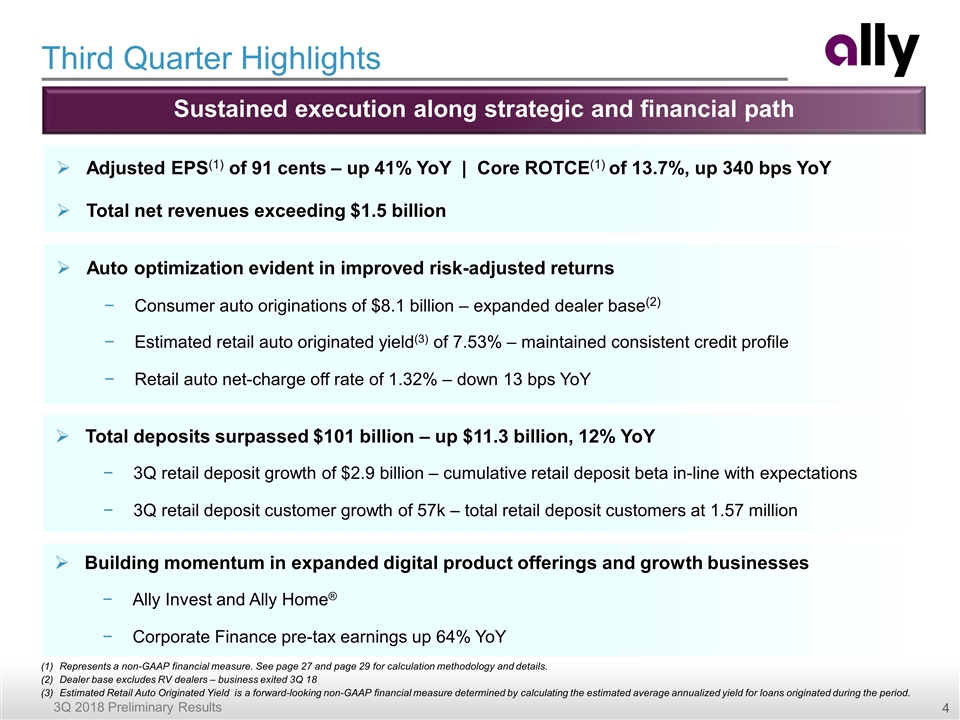
Third Quarter Highlights Represents a non-GAAP financial measure. See page 27 and page 29 for calculation methodology and details. Dealer base excludes RV dealers – business exited 3Q 18 Estimated Retail Auto Originated Yield is a forward-looking non-GAAP financial measure determined by calculating the estimated average annualized yield for loans originated during the period. Sustained execution along strategic and financial path Adjusted EPS(1) of 91 cents – up 41% YoY | Core ROTCE(1) of 13.7%, up 340 bps YoY Total net revenues exceeding $1.5 billion Auto optimization evident in improved risk-adjusted returns Consumer auto originations of $8.1 billion – expanded dealer base(2) Estimated retail auto originated yield(3) of 7.53% – maintained consistent credit profile Retail auto net-charge off rate of 1.32% – down 13 bps YoY Total deposits surpassed $101 billion – up $11.3 billion, 12% YoY 3Q retail deposit growth of $2.9 billion – cumulative retail deposit beta in-line with expectations 3Q retail deposit customer growth of 57k – total retail deposit customers at 1.57 million Building momentum in expanded digital product offerings and growth businesses Ally Invest and Ally Home® Corporate Finance pre-tax earnings up 64% YoY
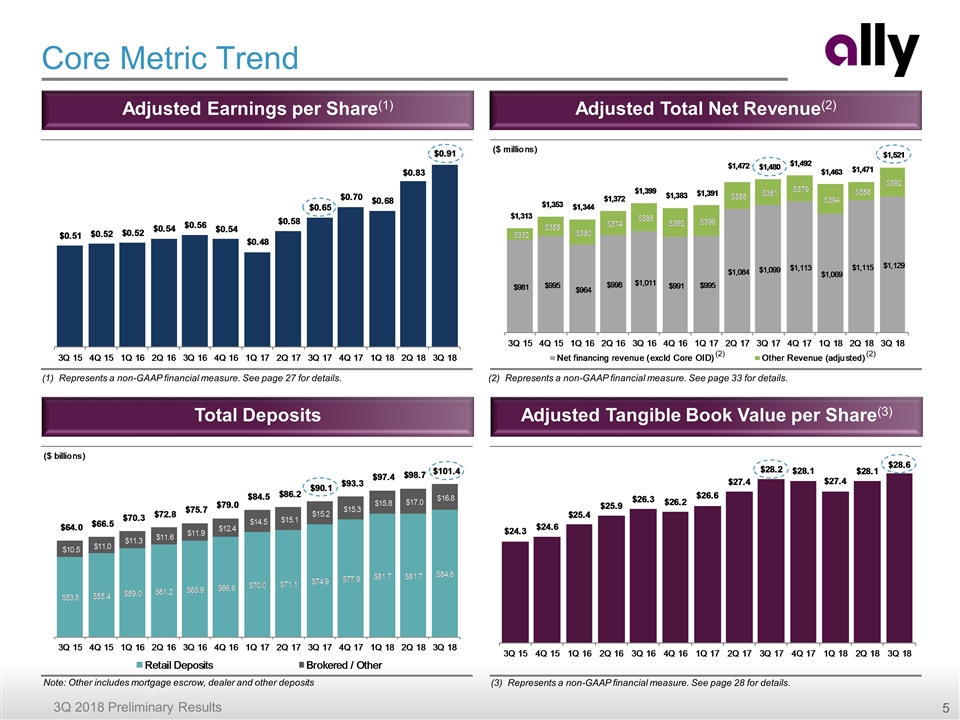
Core Metric Trend Adjusted Earnings per Share(1) Adjusted Total Net Revenue(2) Total Deposits Adjusted Tangible Book Value per Share(3) (3) Represents a non-GAAP financial measure. See page 28 for details. (1) Represents a non-GAAP financial measure. See page 27 for details. (2) Represents a non-GAAP financial measure. See page 33 for details. Note: Other includes mortgage escrow, dealer and other deposits (2) (2)
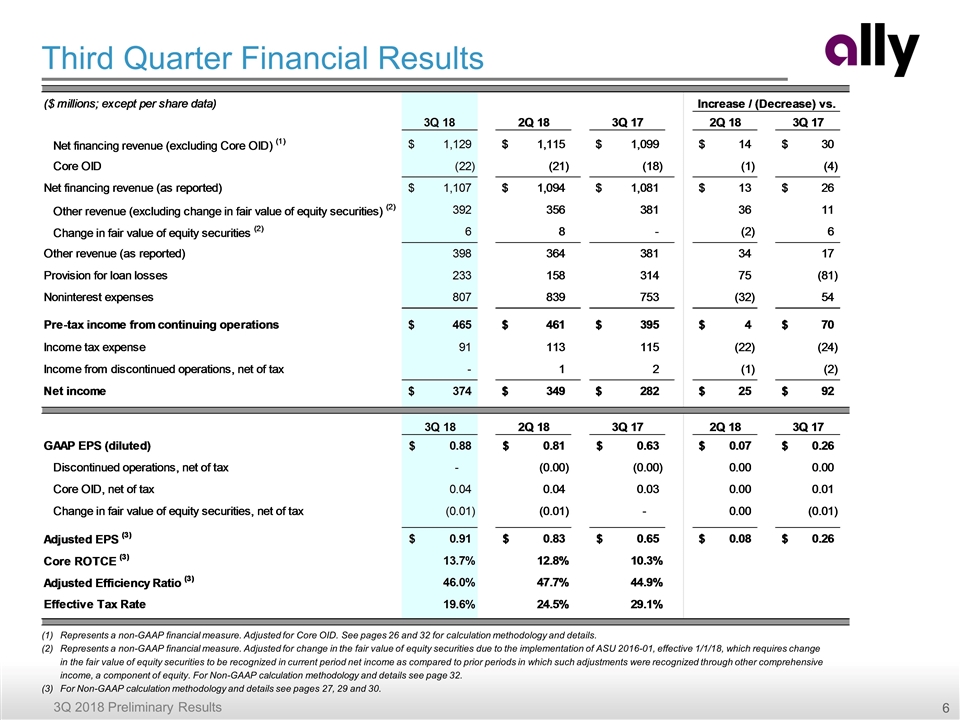
Third Quarter Financial Results Represents a non-GAAP financial measure. Adjusted for Core OID. See pages 26 and 32 for calculation methodology and details. Represents a non-GAAP financial measure. Adjusted for change in the fair value of equity securities due to the implementation of ASU 2016-01, effective 1/1/18, which requires change in the fair value of equity securities to be recognized in current period net income as compared to prior periods in which such adjustments were recognized through other comprehensive income, a component of equity. For Non-GAAP calculation methodology and details see page 32. For Non-GAAP calculation methodology and details see pages 27, 29 and 30.
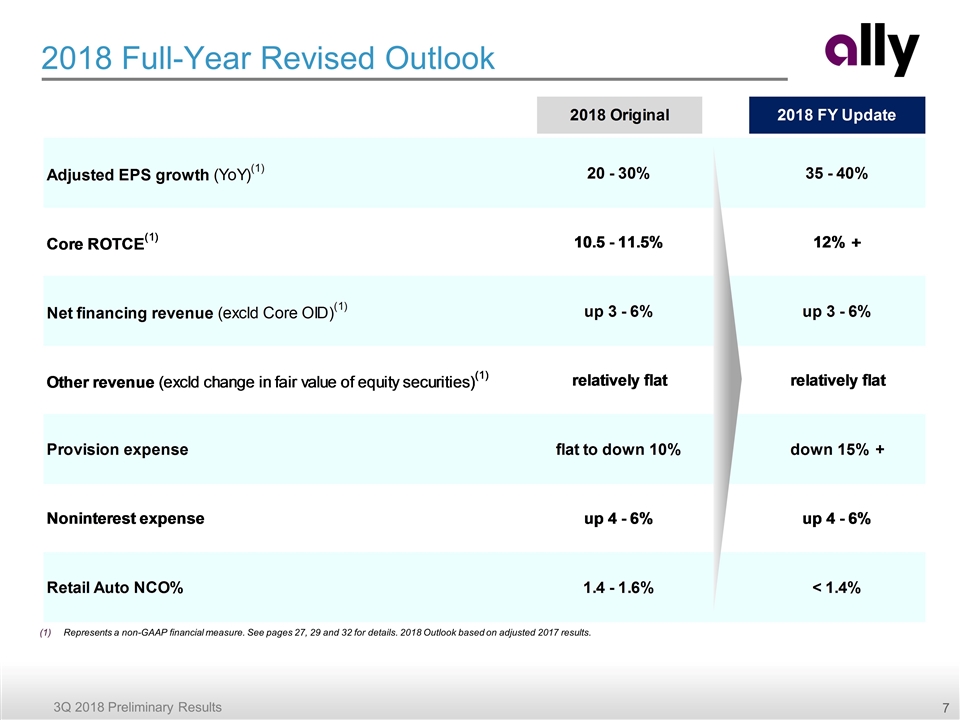
2018 Full-Year Revised Outlook Represents a non-GAAP financial measure. See pages 27, 29 and 32 for details. 2018 Outlook based on adjusted 2017 results.
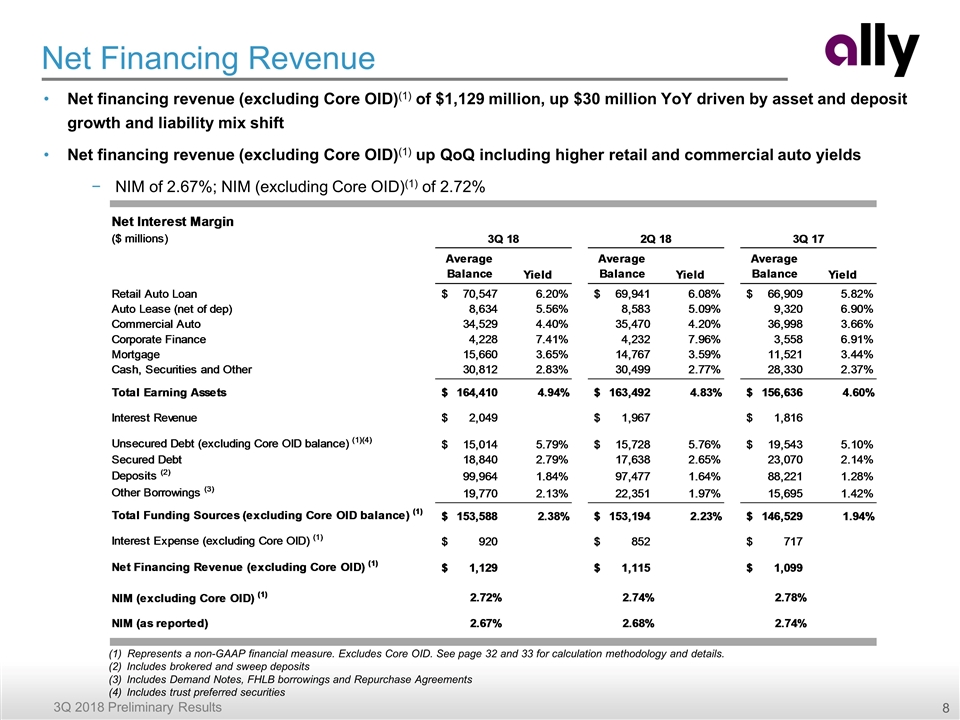
Net Financing Revenue Net financing revenue (excluding Core OID)(1) of $1,129 million, up $30 million YoY driven by asset and deposit growth and liability mix shift Net financing revenue (excluding Core OID)(1) up QoQ including higher retail and commercial auto yields NIM of 2.67%; NIM (excluding Core OID)(1) of 2.72% Represents a non-GAAP financial measure. Excludes Core OID. See page 32 and 33 for calculation methodology and details. Includes brokered and sweep deposits Includes Demand Notes, FHLB borrowings and Repurchase Agreements Includes trust preferred securities
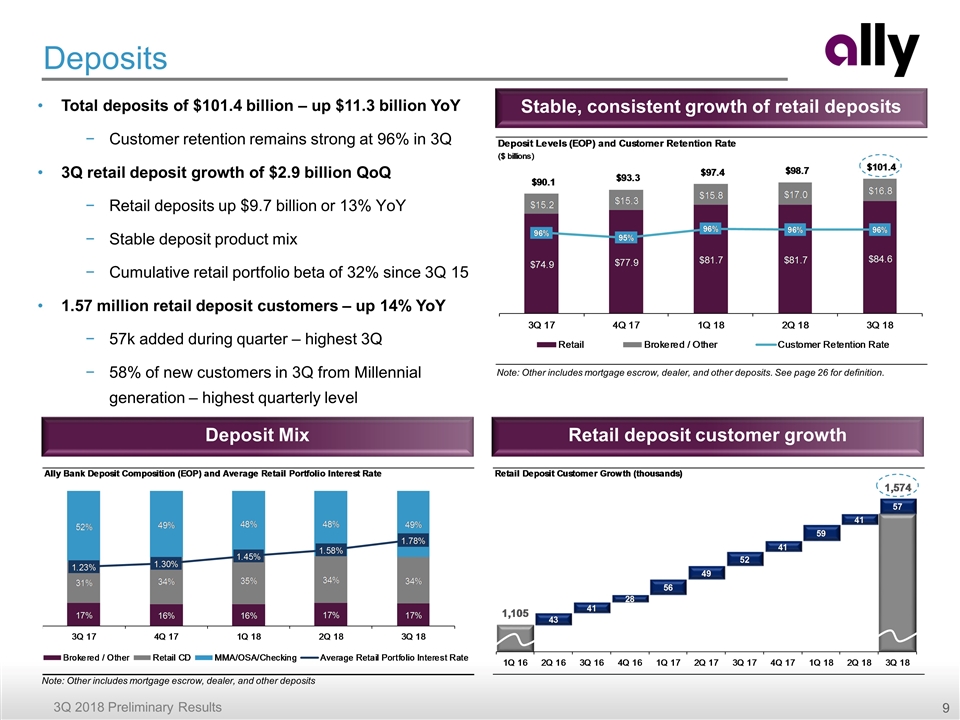
Deposits Total deposits of $101.4 billion – up $11.3 billion YoY Customer retention remains strong at 96% in 3Q 3Q retail deposit growth of $2.9 billion QoQ Retail deposits up $9.7 billion or 13% YoY Stable deposit product mix Cumulative retail portfolio beta of 32% since 3Q 15 1.57 million retail deposit customers – up 14% YoY 57k added during quarter – highest 3Q 58% of new customers in 3Q from Millennial generation – highest quarterly level Stable, consistent growth of retail deposits Deposit Mix Retail deposit customer growth Note: Other includes mortgage escrow, dealer, and other deposits. See page 26 for definition. Note: Other includes mortgage escrow, dealer, and other deposits
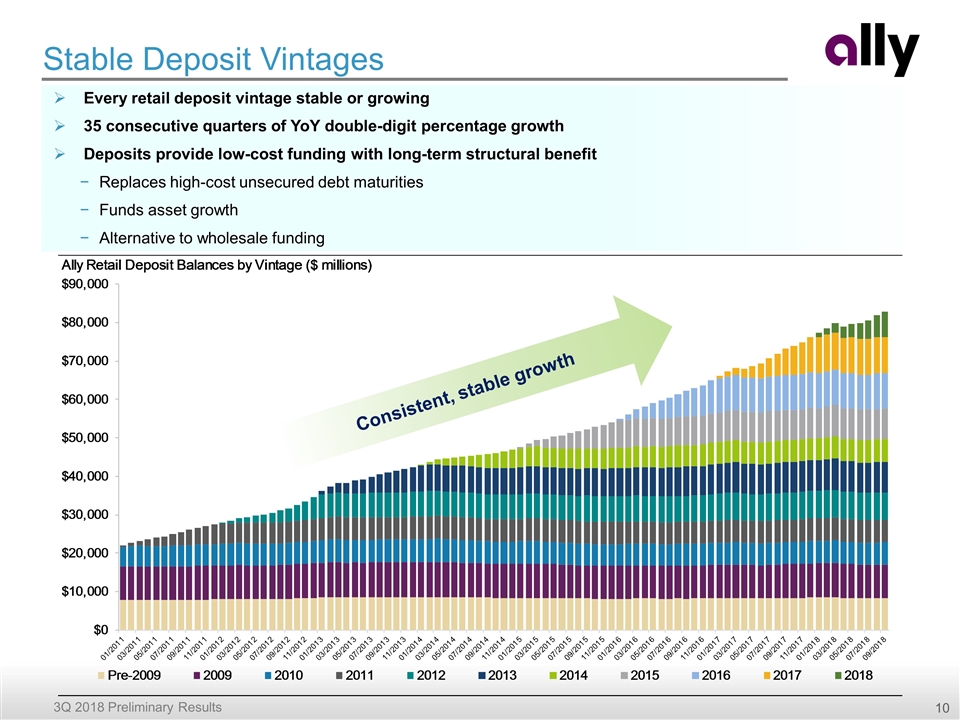
Stable Deposit Vintages Every retail deposit vintage stable or growing 35 consecutive quarters of YoY double-digit percentage growth Deposits provide low-cost funding with long-term structural benefit Replaces high-cost unsecured debt maturities Funds asset growth Alternative to wholesale funding Consistent, stable growth
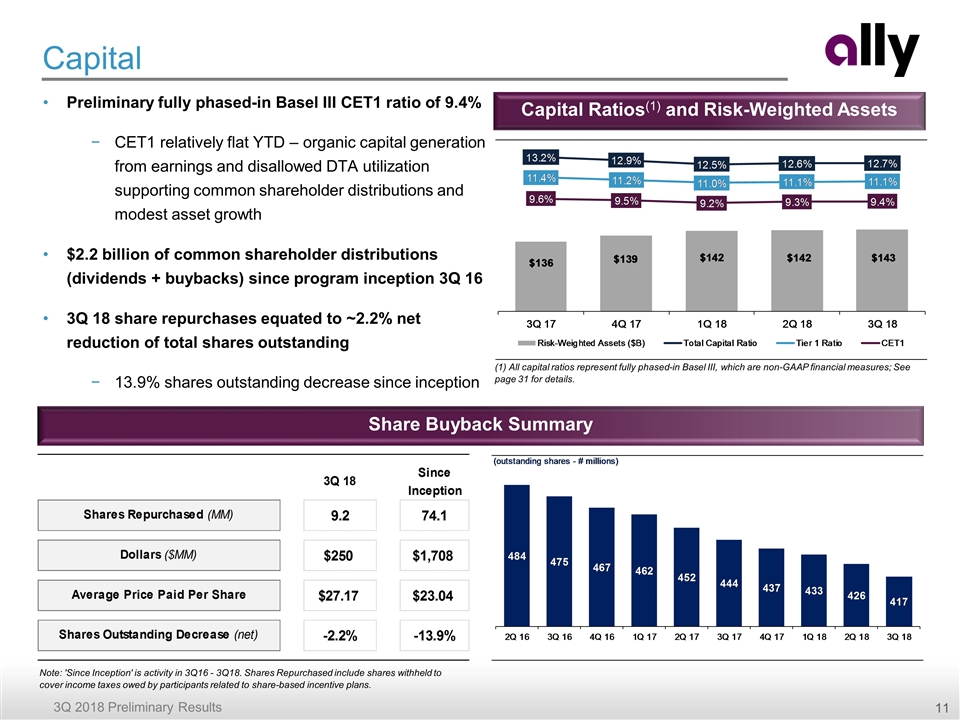
Capital (1) All capital ratios represent fully phased-in Basel III, which are non-GAAP financial measures; See page 31 for details. Capital Ratios(1) and Risk-Weighted Assets Share Buyback Summary Preliminary fully phased-in Basel III CET1 ratio of 9.4% CET1 relatively flat YTD – organic capital generation from earnings and disallowed DTA utilization supporting common shareholder distributions and modest asset growth $2.2 billion of common shareholder distributions (dividends + buybacks) since program inception 3Q 16 3Q 18 share repurchases equated to ~2.2% net reduction of total shares outstanding 13.9% shares outstanding decrease since inception Note: 'Since Inception' is activity in 3Q16 - 3Q18. Shares Repurchased include shares withheld to cover income taxes owed by participants related to share-based incentive plans.
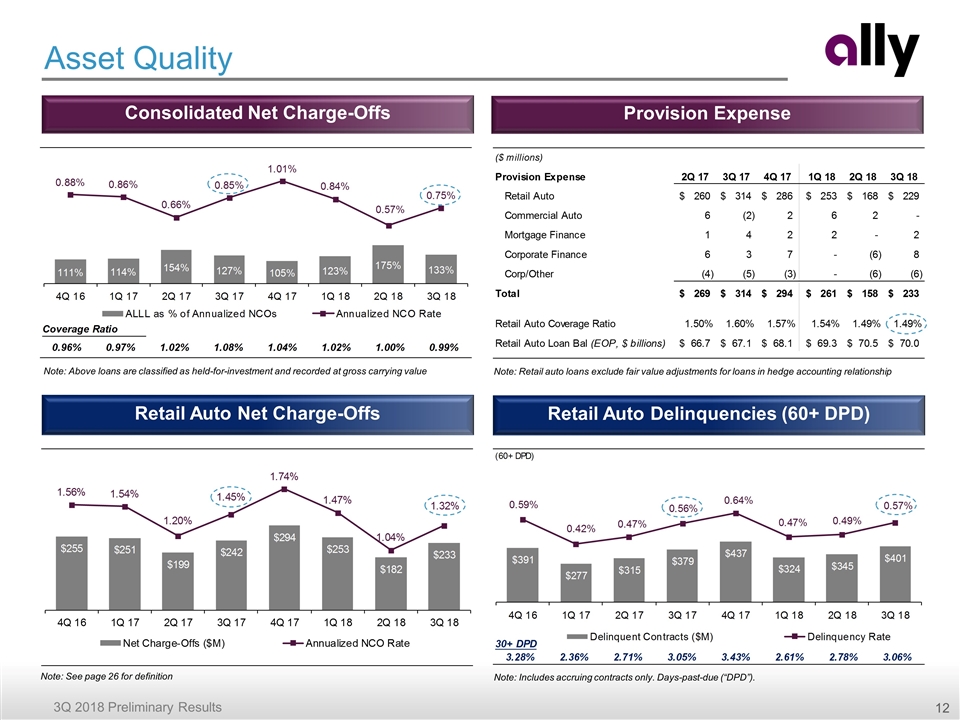
Consolidated Net Charge-Offs Provision Expense Asset Quality Retail Auto Net Charge-Offs Retail Auto Delinquencies (60+ DPD) Note: Above loans are classified as held-for-investment and recorded at gross carrying value Note: Includes accruing contracts only. Days-past-due (“DPD”). Note: See page 26 for definition Note: Retail auto loans exclude fair value adjustments for loans in hedge accounting relationship
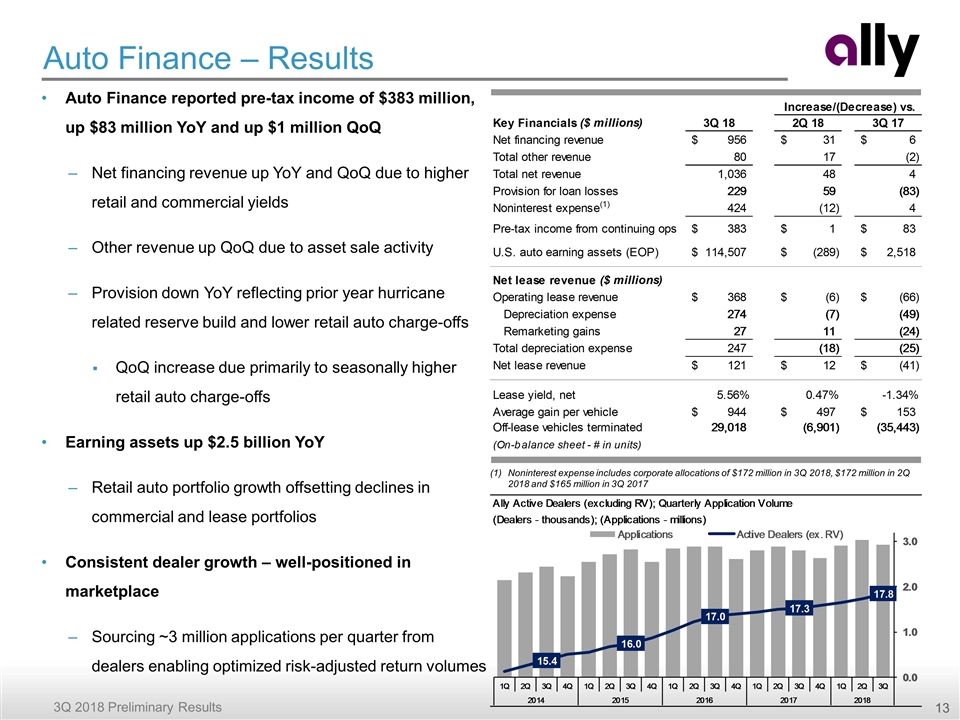
Auto Finance reported pre-tax income of $383 million, up $83 million YoY and up $1 million QoQ Net financing revenue up YoY and QoQ due to higher retail and commercial yields Other revenue up QoQ due to asset sale activity Provision down YoY reflecting prior year hurricane related reserve build and lower retail auto charge-offs QoQ increase due primarily to seasonally higher retail auto charge-offs Earning assets up $2.5 billion YoY Retail auto portfolio growth offsetting declines in commercial and lease portfolios Consistent dealer growth – well-positioned in marketplace Sourcing ~3 million applications per quarter from dealers enabling optimized risk-adjusted return volumes Auto Finance – Results Noninterest expense includes corporate allocations of $172 million in 3Q 2018, $172 million in 2Q 2018 and $165 million in 3Q 2017
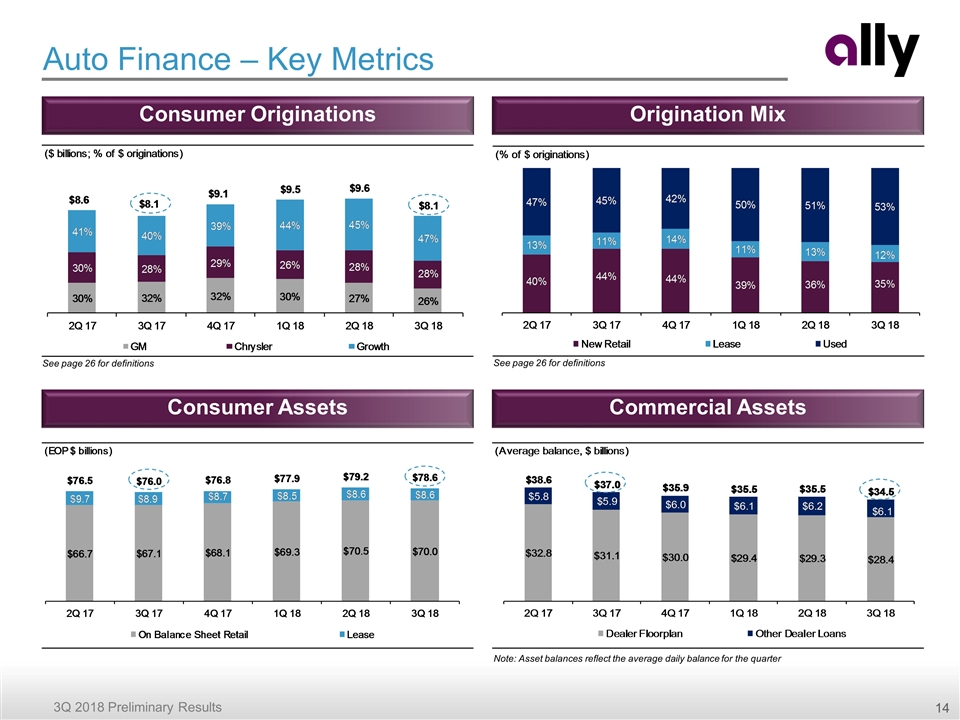
Auto Finance – Key Metrics See page 26 for definitions Consumer Assets Commercial Assets Consumer Originations Origination Mix Note: Asset balances reflect the average daily balance for the quarter See page 26 for definitions
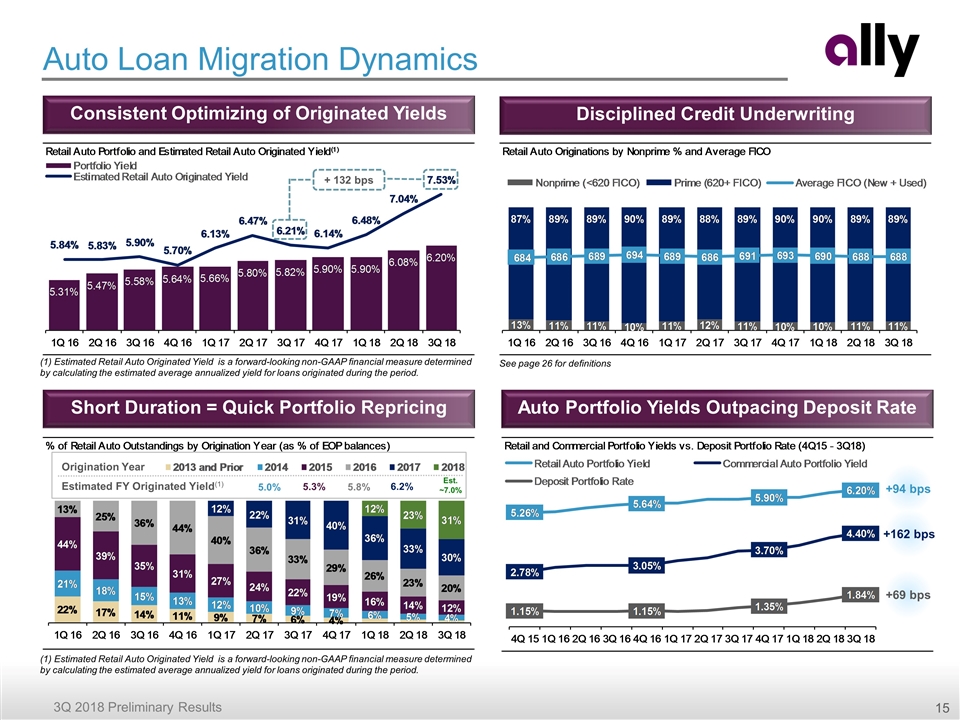
Auto Loan Migration Dynamics Disciplined Credit Underwriting Short Duration = Quick Portfolio Repricing Consistent Optimizing of Originated Yields + 132 bps Auto Portfolio Yields Outpacing Deposit Rate +94 bps +162 bps +69 bps Origination Year Estimated FY Originated Yield(1) 5.0% 5.3% 5.8% 6.2% Est. ~7.0% See page 26 for definitions (1) Estimated Retail Auto Originated Yield is a forward-looking non-GAAP financial measure determined by calculating the estimated average annualized yield for loans originated during the period. (1) Estimated Retail Auto Originated Yield is a forward-looking non-GAAP financial measure determined by calculating the estimated average annualized yield for loans originated during the period.
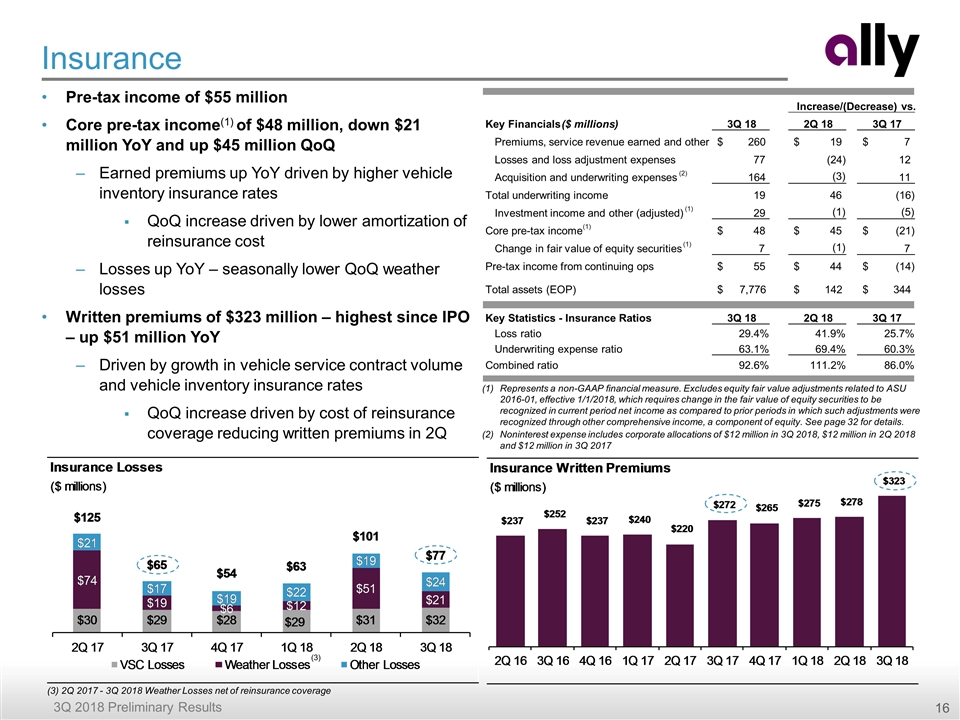
Insurance Pre-tax income of $55 million Core pre-tax income(1) of $48 million, down $21 million YoY and up $45 million QoQ Earned premiums up YoY driven by higher vehicle inventory insurance rates QoQ increase driven by lower amortization of reinsurance cost Losses up YoY – seasonally lower QoQ weather losses Written premiums of $323 million – highest since IPO – up $51 million YoY Driven by growth in vehicle service contract volume and vehicle inventory insurance rates QoQ increase driven by cost of reinsurance coverage reducing written premiums in 2Q (3) (3) 2Q 2017 - 3Q 2018 Weather Losses net of reinsurance coverage Key Financials ($ millions) 3Q 18 2Q 18 3Q 17 Premiums, service revenue earned and other 260 $ 19 $ 7 $ Losses and loss adjustment expenses 77 (24) 12 Acquisition and underwriting expenses (2) 164 (3) 11 Total underwriting income 19 46 (16) Investment income and other (adjusted) (1) 29 (1) (5) Core pre-tax income (1) 48 $ 45 $ (21) $ Change in fair value of equity securities (1) 7 (1) 7 Pre-tax income from continuing ops 55 $ 44 $ (14) $ Total assets (EOP) 7,776 $ 142 $ 344 $ Key Statistics - Insurance Ratios 3Q 18 2Q 18 3Q 17 Loss ratio 29.4% 41.9% 25.7% Underwriting expense ratio 63.1% 69.4% 60.3% Combined ratio 92.6% 111.2% 86.0% Increase/(Decrease) vs. Represents a non-GAAP financial measure. Excludes equity fair value adjustments related to ASU 2016-01, effective 1/1/2018, which requires change in the fair value of equity securities to be recognized in current period net income as compared to prior periods in which such adjustments were recognized through other comprehensive income, a component of equity. See page 32 for details. Noninterest expense includes corporate allocations of $12 million in 3Q 2018, $12 million in 2Q 2018 and $12 million in 3Q 2017
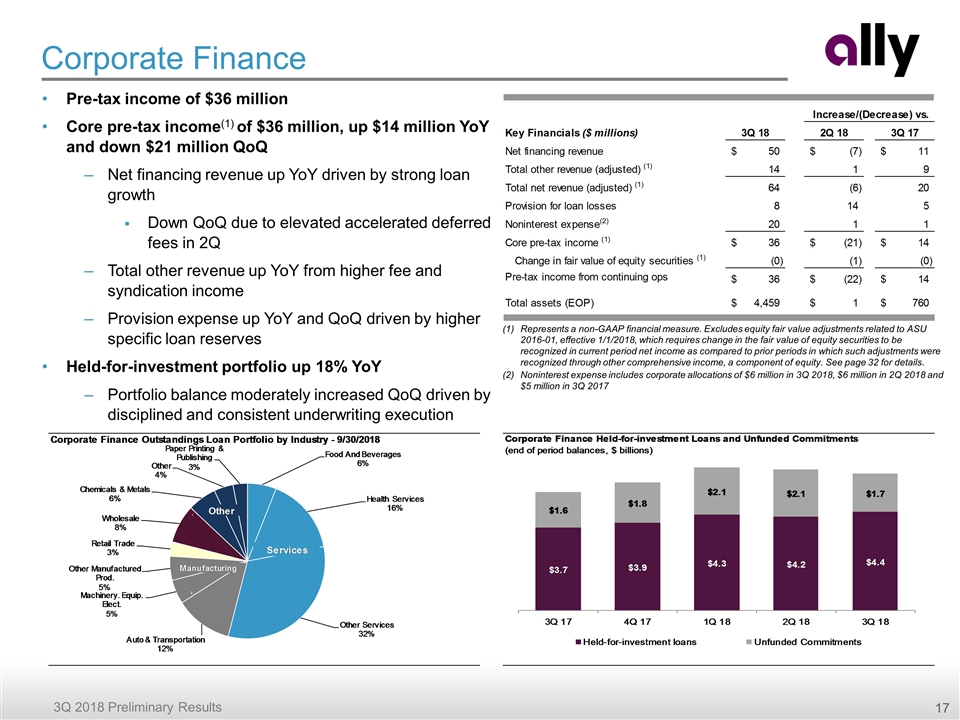
Represents a non-GAAP financial measure. Excludes equity fair value adjustments related to ASU 2016-01, effective 1/1/2018, which requires change in the fair value of equity securities to be recognized in current period net income as compared to prior periods in which such adjustments were recognized through other comprehensive income, a component of equity. See page 32 for details. Noninterest expense includes corporate allocations of $6 million in 3Q 2018, $6 million in 2Q 2018 and $5 million in 3Q 2017 Pre-tax income of $36 million Core pre-tax income(1) of $36 million, up $14 million YoY and down $21 million QoQ Net financing revenue up YoY driven by strong loan growth Down QoQ due to elevated accelerated deferred fees in 2Q Total other revenue up YoY from higher fee and syndication income Provision expense up YoY and QoQ driven by higher specific loan reserves Held-for-investment portfolio up 18% YoY Portfolio balance moderately increased QoQ driven by disciplined and consistent underwriting execution Corporate Finance
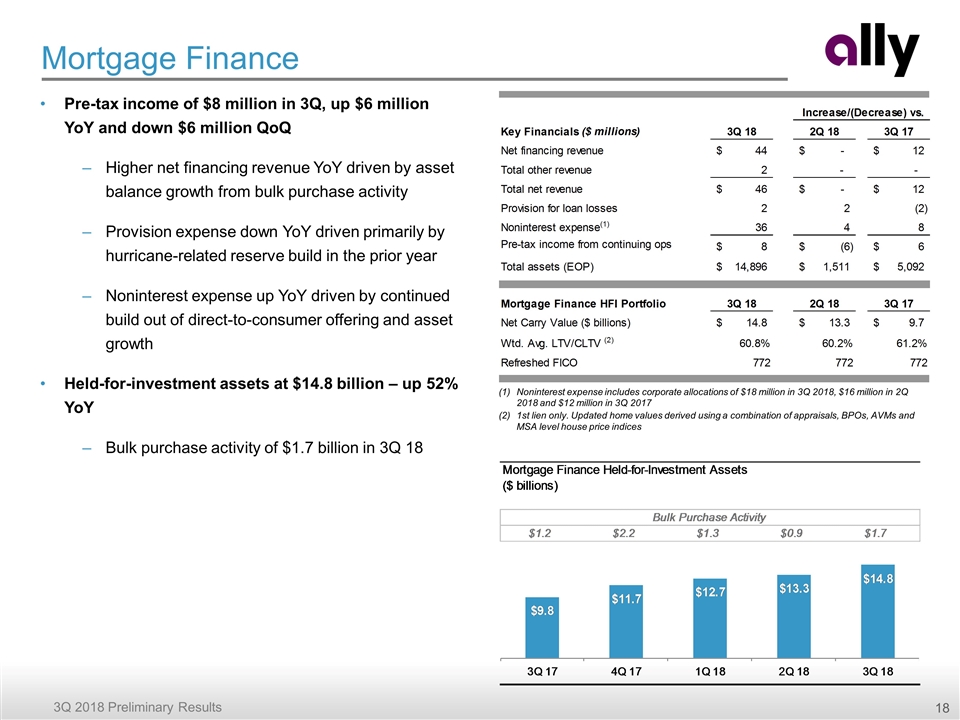
Mortgage Finance Noninterest expense includes corporate allocations of $18 million in 3Q 2018, $16 million in 2Q 2018 and $12 million in 3Q 2017 1st lien only. Updated home values derived using a combination of appraisals, BPOs, AVMs and MSA level house price indices Pre-tax income of $8 million in 3Q, up $6 million YoY and down $6 million QoQ Higher net financing revenue YoY driven by asset balance growth from bulk purchase activity Provision expense down YoY driven primarily by hurricane-related reserve build in the prior year Noninterest expense up YoY driven by continued build out of direct-to-consumer offering and asset growth Held-for-investment assets at $14.8 billion – up 52% YoY Bulk purchase activity of $1.7 billion in 3Q 18
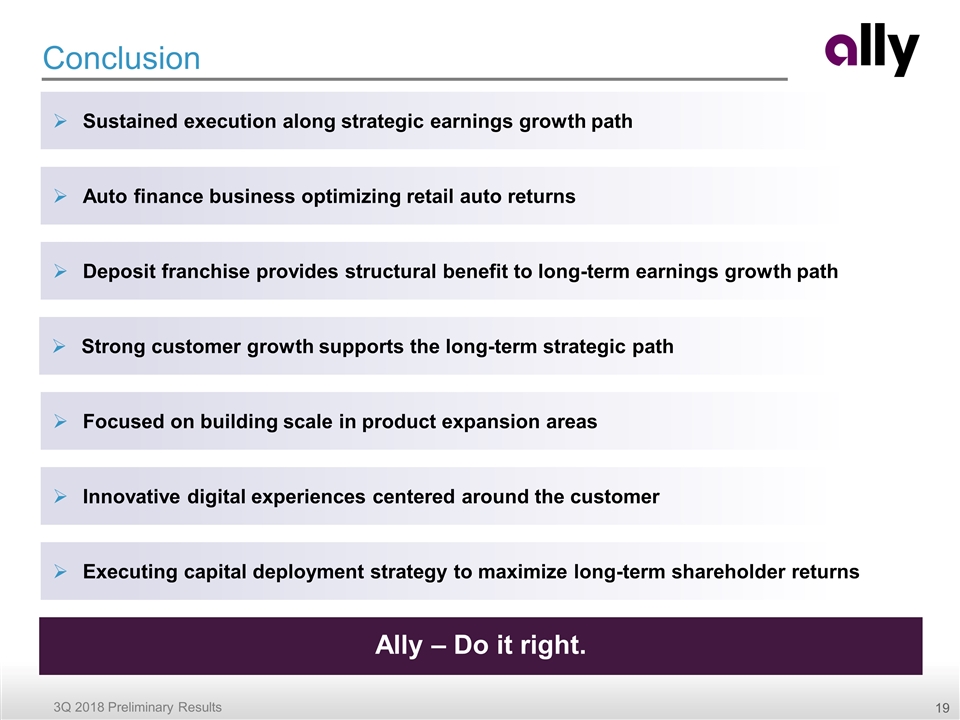
Conclusion Sustained execution along strategic earnings growth path Auto finance business optimizing retail auto returns Focused on building scale in product expansion areas Strong customer growth supports the long-term strategic path Executing capital deployment strategy to maximize long-term shareholder returns Ally – Do it right. Deposit franchise provides structural benefit to long-term earnings growth path Innovative digital experiences centered around the customer
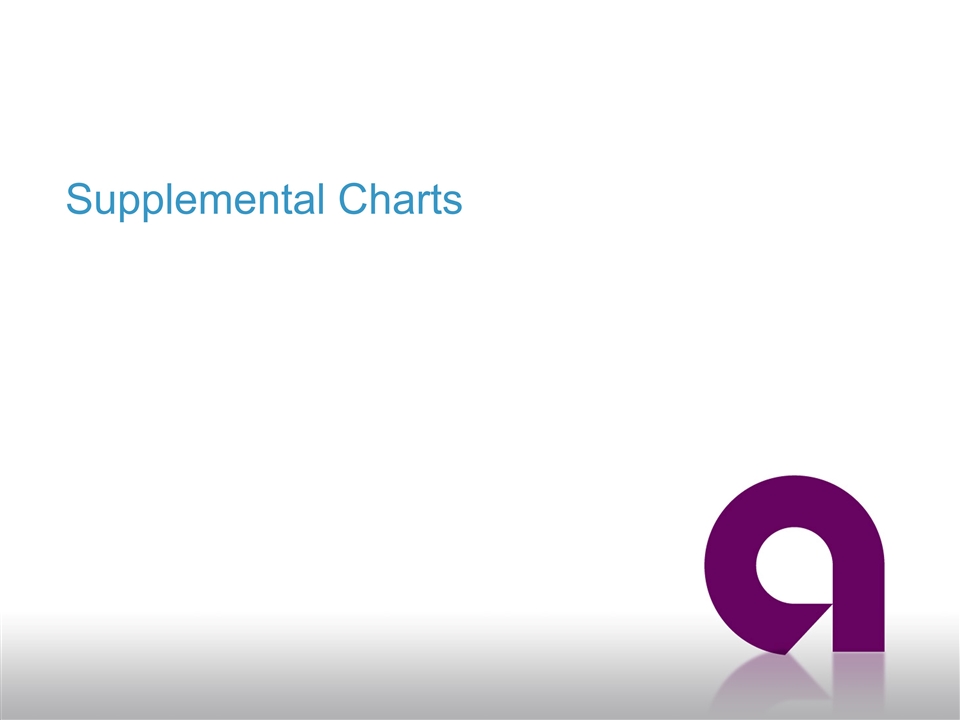
Supplemental Charts
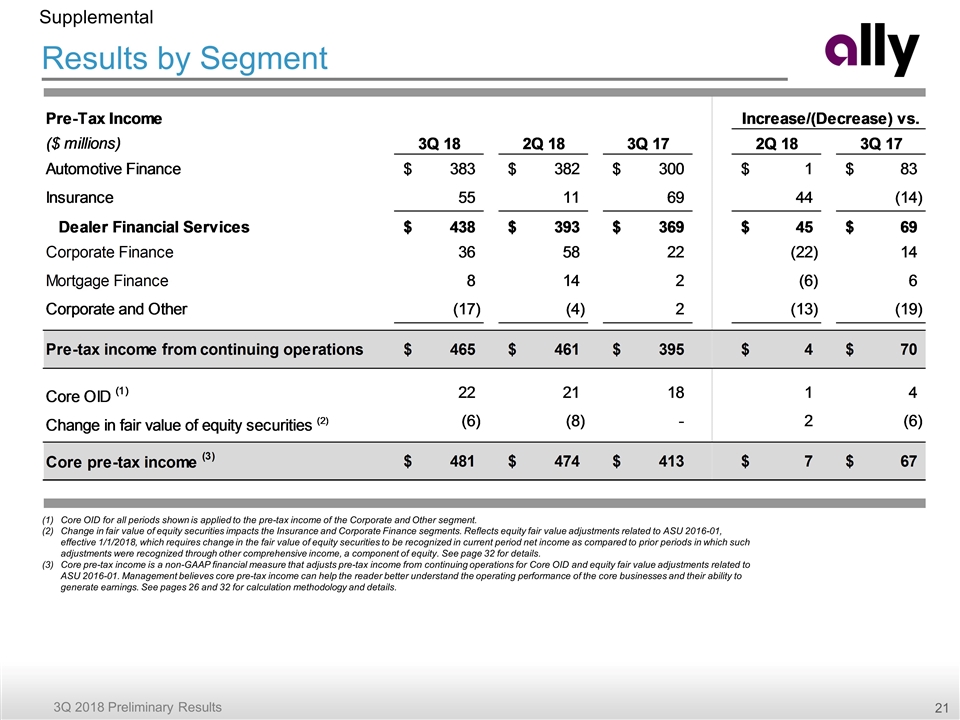
Results by Segment Core OID for all periods shown is applied to the pre-tax income of the Corporate and Other segment. Change in fair value of equity securities impacts the Insurance and Corporate Finance segments. Reflects equity fair value adjustments related to ASU 2016-01, effective 1/1/2018, which requires change in the fair value of equity securities to be recognized in current period net income as compared to prior periods in which such adjustments were recognized through other comprehensive income, a component of equity. See page 32 for details. Core pre-tax income is a non-GAAP financial measure that adjusts pre-tax income from continuing operations for Core OID and equity fair value adjustments related to ASU 2016-01. Management believes core pre-tax income can help the reader better understand the operating performance of the core businesses and their ability to generate earnings. See pages 26 and 32 for calculation methodology and details. Supplemental
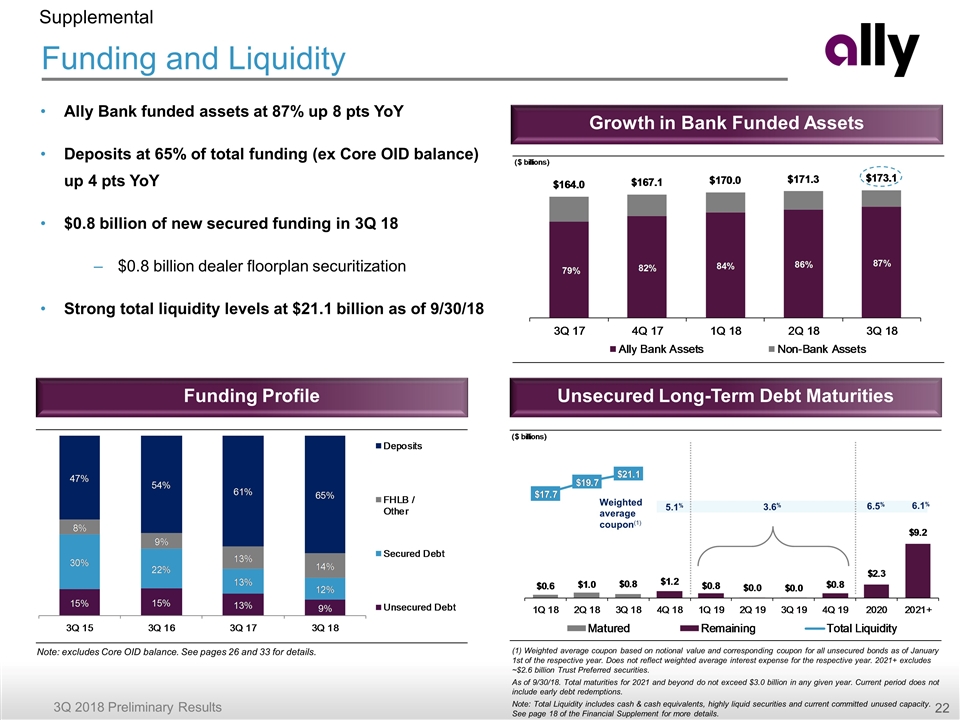
Ally Bank funded assets at 87% up 8 pts YoY Deposits at 65% of total funding (ex Core OID balance) up 4 pts YoY $0.8 billion of new secured funding in 3Q 18 $0.8 billion dealer floorplan securitization Strong total liquidity levels at $21.1 billion as of 9/30/18 Funding and Liquidity (1) Weighted average coupon based on notional value and corresponding coupon for all unsecured bonds as of January 1st of the respective year. Does not reflect weighted average interest expense for the respective year. 2021+ excludes ~$2.6 billion Trust Preferred securities. As of 9/30/18. Total maturities for 2021 and beyond do not exceed $3.0 billion in any given year. Current period does not include early debt redemptions. Note: Total Liquidity includes cash & cash equivalents, highly liquid securities and current committed unused capacity. See page 18 of the Financial Supplement for more details. Unsecured Long-Term Debt Maturities Growth in Bank Funded Assets Funding Profile Supplemental Note: excludes Core OID balance. See pages 26 and 33 for details. Weighted average coupon(1) 3.6% 6.5% 6.1% 5.1%
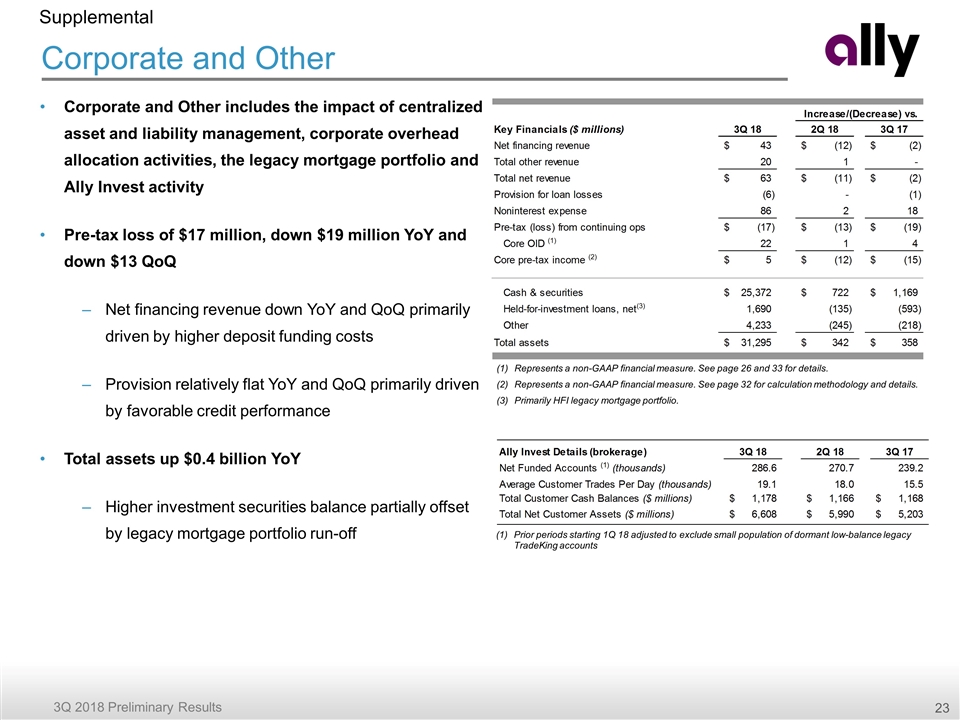
Represents a non-GAAP financial measure. See page 26 and 33 for details. Represents a non-GAAP financial measure. See page 32 for calculation methodology and details. Primarily HFI legacy mortgage portfolio. Corporate and Other Supplemental Corporate and Other includes the impact of centralized asset and liability management, corporate overhead allocation activities, the legacy mortgage portfolio and Ally Invest activity Pre-tax loss of $17 million, down $19 million YoY and down $13 QoQ Net financing revenue down YoY and QoQ primarily driven by higher deposit funding costs Provision relatively flat YoY and QoQ primarily driven by favorable credit performance Total assets up $0.4 billion YoY Higher investment securities balance partially offset by legacy mortgage portfolio run-off Prior periods starting 1Q 18 adjusted to exclude small population of dormant low-balance legacy TradeKing accounts
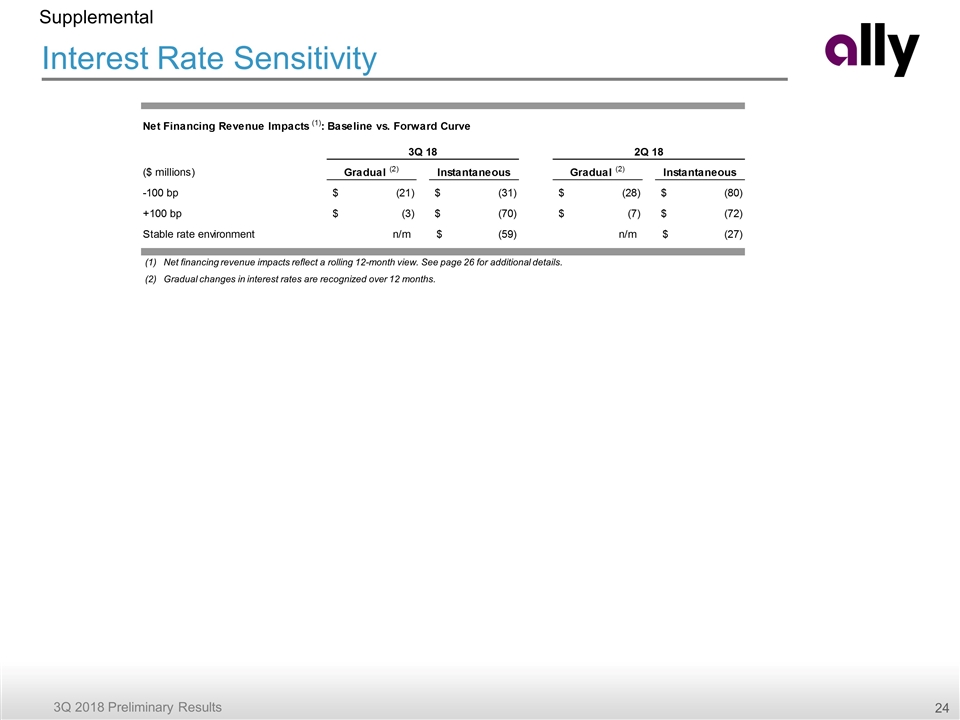
Interest Rate Sensitivity Net financing revenue impacts reflect a rolling 12-month view. See page 26 for additional details. Gradual changes in interest rates are recognized over 12 months. Supplemental
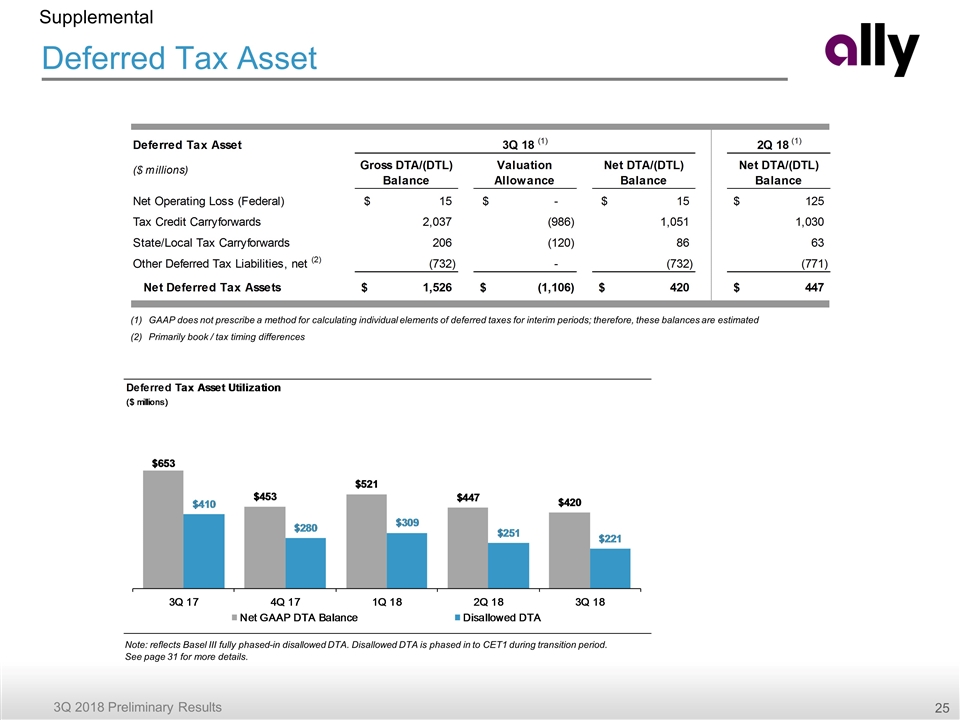
Deferred Tax Asset Supplemental GAAP does not prescribe a method for calculating individual elements of deferred taxes for interim periods; therefore, these balances are estimated Primarily book / tax timing differences Note: reflects Basel III fully phased-in disallowed DTA. Disallowed DTA is phased in to CET1 during transition period. See page 31 for more details.
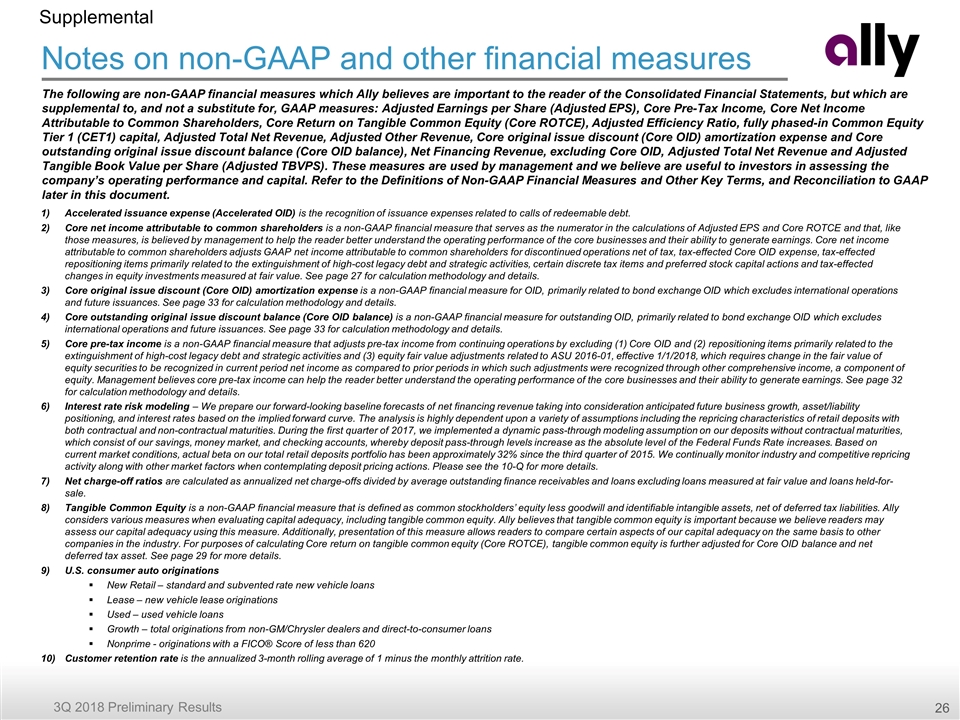
Notes on non-GAAP and other financial measures Supplemental Accelerated issuance expense (Accelerated OID) is the recognition of issuance expenses related to calls of redeemable debt. Core net income attributable to common shareholders is a non-GAAP financial measure that serves as the numerator in the calculations of Adjusted EPS and Core ROTCE and that, like those measures, is believed by management to help the reader better understand the operating performance of the core businesses and their ability to generate earnings. Core net income attributable to common shareholders adjusts GAAP net income attributable to common shareholders for discontinued operations net of tax, tax-effected Core OID expense, tax-effected repositioning items primarily related to the extinguishment of high-cost legacy debt and strategic activities, certain discrete tax items and preferred stock capital actions and tax-effected changes in equity investments measured at fair value. See page 27 for calculation methodology and details. Core original issue discount (Core OID) amortization expense is a non-GAAP financial measure for OID, primarily related to bond exchange OID which excludes international operations and future issuances. See page 33 for calculation methodology and details. Core outstanding original issue discount balance (Core OID balance) is a non-GAAP financial measure for outstanding OID, primarily related to bond exchange OID which excludes international operations and future issuances. See page 33 for calculation methodology and details. Core pre-tax income is a non-GAAP financial measure that adjusts pre-tax income from continuing operations by excluding (1) Core OID and (2) repositioning items primarily related to the extinguishment of high-cost legacy debt and strategic activities and (3) equity fair value adjustments related to ASU 2016-01, effective 1/1/2018, which requires change in the fair value of equity securities to be recognized in current period net income as compared to prior periods in which such adjustments were recognized through other comprehensive income, a component of equity. Management believes core pre-tax income can help the reader better understand the operating performance of the core businesses and their ability to generate earnings. See page 32 for calculation methodology and details. Interest rate risk modeling – We prepare our forward-looking baseline forecasts of net financing revenue taking into consideration anticipated future business growth, asset/liability positioning, and interest rates based on the implied forward curve. The analysis is highly dependent upon a variety of assumptions including the repricing characteristics of retail deposits with both contractual and non-contractual maturities. During the first quarter of 2017, we implemented a dynamic pass-through modeling assumption on our deposits without contractual maturities, which consist of our savings, money market, and checking accounts, whereby deposit pass-through levels increase as the absolute level of the Federal Funds Rate increases. Based on current market conditions, actual beta on our total retail deposits portfolio has been approximately 32% since the third quarter of 2015. We continually monitor industry and competitive repricing activity along with other market factors when contemplating deposit pricing actions. Please see the 10-Q for more details. Net charge-off ratios are calculated as annualized net charge-offs divided by average outstanding finance receivables and loans excluding loans measured at fair value and loans held-for-sale. Tangible Common Equity is a non-GAAP financial measure that is defined as common stockholders’ equity less goodwill and identifiable intangible assets, net of deferred tax liabilities. Ally considers various measures when evaluating capital adequacy, including tangible common equity. Ally believes that tangible common equity is important because we believe readers may assess our capital adequacy using this measure. Additionally, presentation of this measure allows readers to compare certain aspects of our capital adequacy on the same basis to other companies in the industry. For purposes of calculating Core return on tangible common equity (Core ROTCE), tangible common equity is further adjusted for Core OID balance and net deferred tax asset. See page 29 for more details. U.S. consumer auto originations New Retail – standard and subvented rate new vehicle loans Lease – new vehicle lease originations Used – used vehicle loans Growth – total originations from non-GM/Chrysler dealers and direct-to-consumer loans Nonprime - originations with a FICO® Score of less than 620 Customer retention rate is the annualized 3-month rolling average of 1 minus the monthly attrition rate. The following are non-GAAP financial measures which Ally believes are important to the reader of the Consolidated Financial Statements, but which are supplemental to, and not a substitute for, GAAP measures: Adjusted Earnings per Share (Adjusted EPS), Core Pre-Tax Income, Core Net Income Attributable to Common Shareholders, Core Return on Tangible Common Equity (Core ROTCE), Adjusted Efficiency Ratio, fully phased-in Common Equity Tier 1 (CET1) capital, Adjusted Total Net Revenue, Adjusted Other Revenue, Core original issue discount (Core OID) amortization expense and Core outstanding original issue discount balance (Core OID balance), Net Financing Revenue, excluding Core OID, Adjusted Total Net Revenue and Adjusted Tangible Book Value per Share (Adjusted TBVPS). These measures are used by management and we believe are useful to investors in assessing the company’s operating performance and capital. Refer to the Definitions of Non-GAAP Financial Measures and Other Key Terms, and Reconciliation to GAAP later in this document.
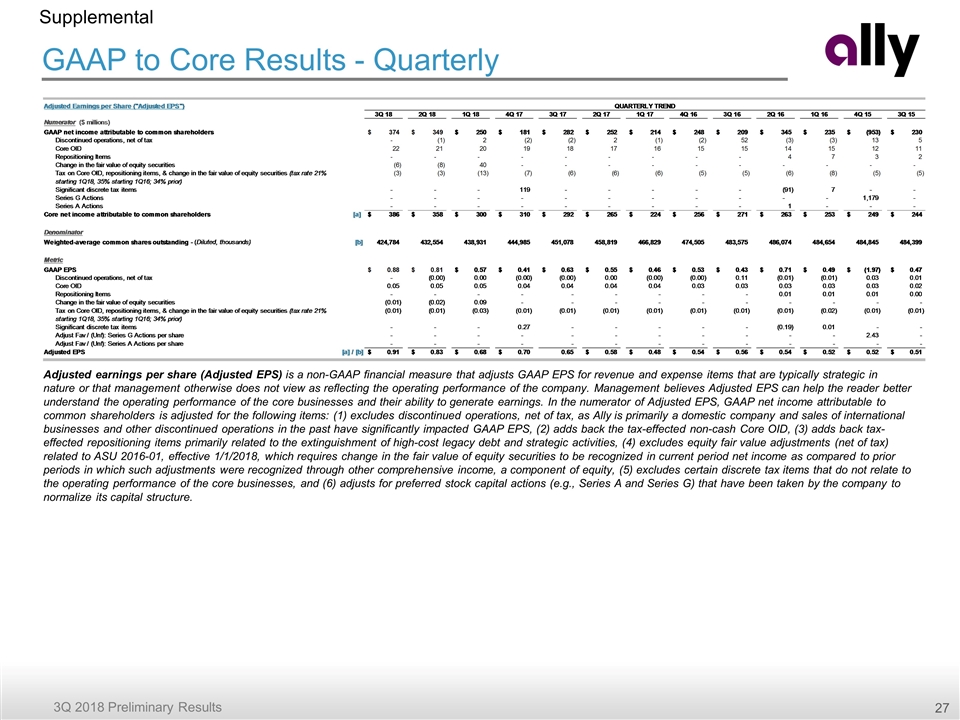
GAAP to Core Results - Quarterly Supplemental Adjusted earnings per share (Adjusted EPS) is a non-GAAP financial measure that adjusts GAAP EPS for revenue and expense items that are typically strategic in nature or that management otherwise does not view as reflecting the operating performance of the company. Management believes Adjusted EPS can help the reader better understand the operating performance of the core businesses and their ability to generate earnings. In the numerator of Adjusted EPS, GAAP net income attributable to common shareholders is adjusted for the following items: (1) excludes discontinued operations, net of tax, as Ally is primarily a domestic company and sales of international businesses and other discontinued operations in the past have significantly impacted GAAP EPS, (2) adds back the tax-effected non-cash Core OID, (3) adds back tax-effected repositioning items primarily related to the extinguishment of high-cost legacy debt and strategic activities, (4) excludes equity fair value adjustments (net of tax) related to ASU 2016-01, effective 1/1/2018, which requires change in the fair value of equity securities to be recognized in current period net income as compared to prior periods in which such adjustments were recognized through other comprehensive income, a component of equity, (5) excludes certain discrete tax items that do not relate to the operating performance of the core businesses, and (6) adjusts for preferred stock capital actions (e.g., Series A and Series G) that have been taken by the company to normalize its capital structure.
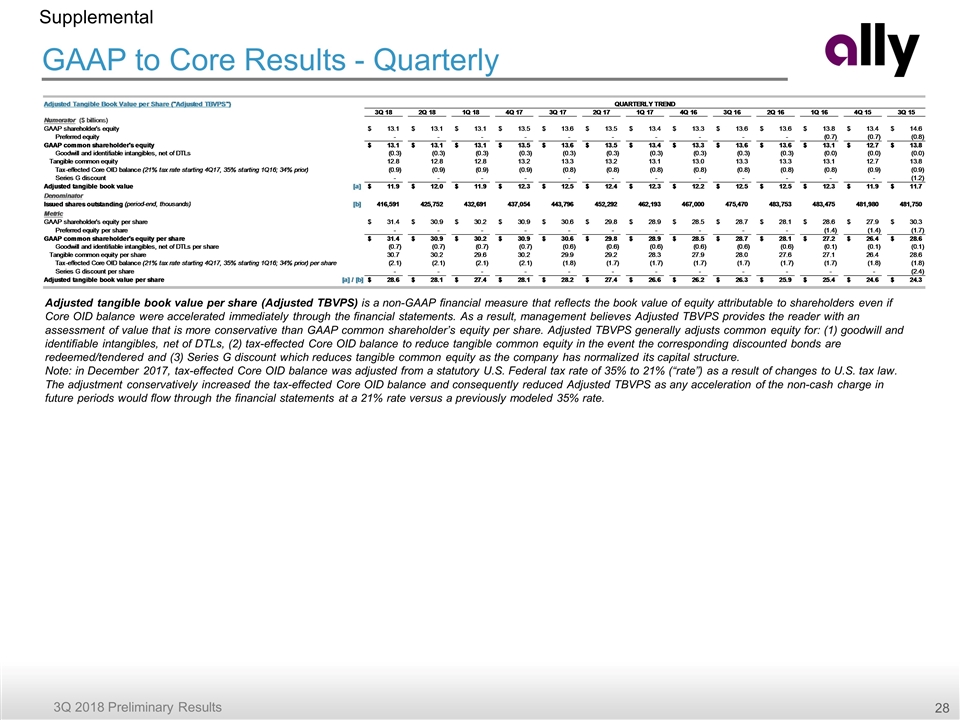
GAAP to Core Results - Quarterly Supplemental Adjusted tangible book value per share (Adjusted TBVPS) is a non-GAAP financial measure that reflects the book value of equity attributable to shareholders even if Core OID balance were accelerated immediately through the financial statements. As a result, management believes Adjusted TBVPS provides the reader with an assessment of value that is more conservative than GAAP common shareholder’s equity per share. Adjusted TBVPS generally adjusts common equity for: (1) goodwill and identifiable intangibles, net of DTLs, (2) tax-effected Core OID balance to reduce tangible common equity in the event the corresponding discounted bonds are redeemed/tendered and (3) Series G discount which reduces tangible common equity as the company has normalized its capital structure. Note: in December 2017, tax-effected Core OID balance was adjusted from a statutory U.S. Federal tax rate of 35% to 21% (“rate”) as a result of changes to U.S. tax law. The adjustment conservatively increased the tax-effected Core OID balance and consequently reduced Adjusted TBVPS as any acceleration of the non-cash charge in future periods would flow through the financial statements at a 21% rate versus a previously modeled 35% rate.
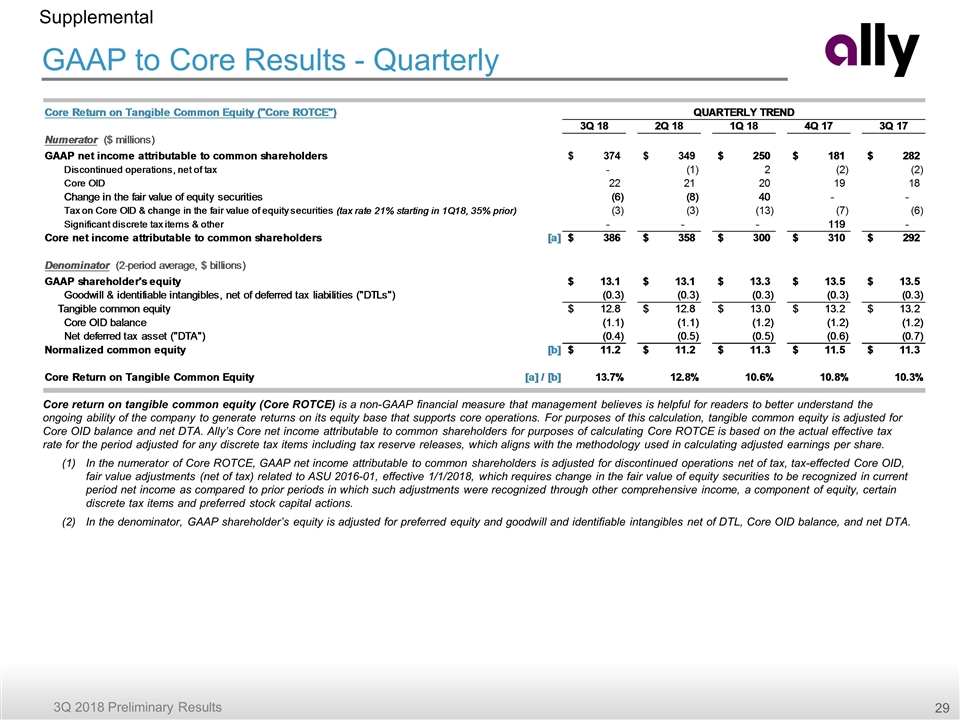
GAAP to Core Results - Quarterly Supplemental Core return on tangible common equity (Core ROTCE) is a non-GAAP financial measure that management believes is helpful for readers to better understand the ongoing ability of the company to generate returns on its equity base that supports core operations. For purposes of this calculation, tangible common equity is adjusted for Core OID balance and net DTA. Ally’s Core net income attributable to common shareholders for purposes of calculating Core ROTCE is based on the actual effective tax rate for the period adjusted for any discrete tax items including tax reserve releases, which aligns with the methodology used in calculating adjusted earnings per share. In the numerator of Core ROTCE, GAAP net income attributable to common shareholders is adjusted for discontinued operations net of tax, tax-effected Core OID, fair value adjustments (net of tax) related to ASU 2016-01, effective 1/1/2018, which requires change in the fair value of equity securities to be recognized in current period net income as compared to prior periods in which such adjustments were recognized through other comprehensive income, a component of equity, certain discrete tax items and preferred stock capital actions. In the denominator, GAAP shareholder’s equity is adjusted for preferred equity and goodwill and identifiable intangibles net of DTL, Core OID balance, and net DTA.
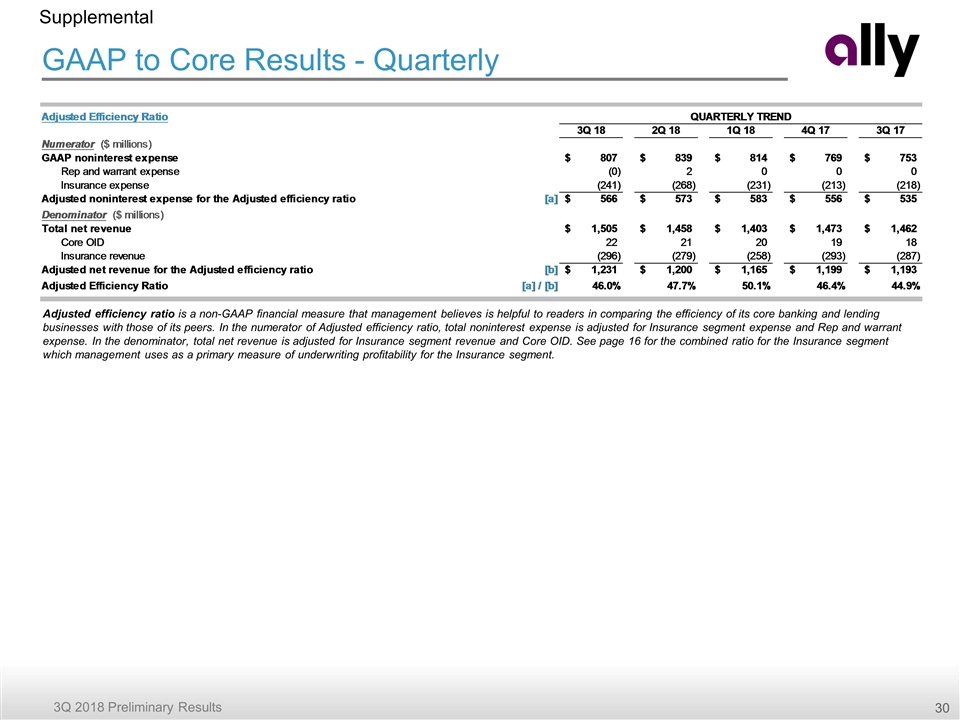
GAAP to Core Results - Quarterly Supplemental Adjusted efficiency ratio is a non-GAAP financial measure that management believes is helpful to readers in comparing the efficiency of its core banking and lending businesses with those of its peers. In the numerator of Adjusted efficiency ratio, total noninterest expense is adjusted for Insurance segment expense and Rep and warrant expense. In the denominator, total net revenue is adjusted for Insurance segment revenue and Core OID. See page 16 for the combined ratio for the Insurance segment which management uses as a primary measure of underwriting profitability for the Insurance segment.
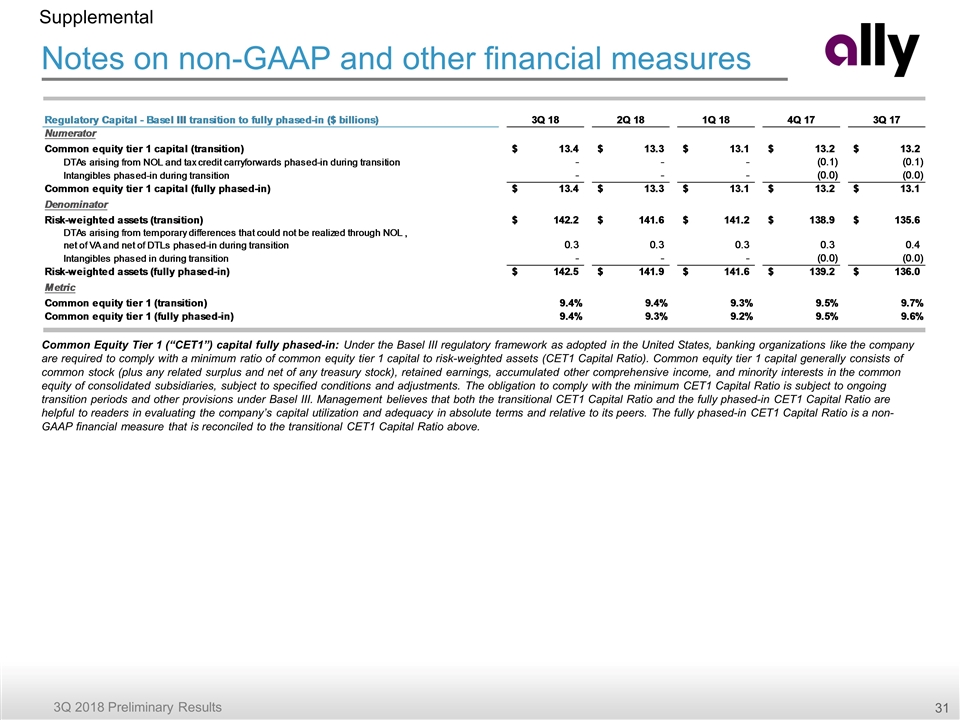
Notes on non-GAAP and other financial measures Supplemental Common Equity Tier 1 (“CET1”) capital fully phased-in: Under the Basel III regulatory framework as adopted in the United States, banking organizations like the company are required to comply with a minimum ratio of common equity tier 1 capital to risk-weighted assets (CET1 Capital Ratio). Common equity tier 1 capital generally consists of common stock (plus any related surplus and net of any treasury stock), retained earnings, accumulated other comprehensive income, and minority interests in the common equity of consolidated subsidiaries, subject to specified conditions and adjustments. The obligation to comply with the minimum CET1 Capital Ratio is subject to ongoing transition periods and other provisions under Basel III. Management believes that both the transitional CET1 Capital Ratio and the fully phased-in CET1 Capital Ratio are helpful to readers in evaluating the company’s capital utilization and adequacy in absolute terms and relative to its peers. The fully phased-in CET1 Capital Ratio is a non-GAAP financial measure that is reconciled to the transitional CET1 Capital Ratio above.
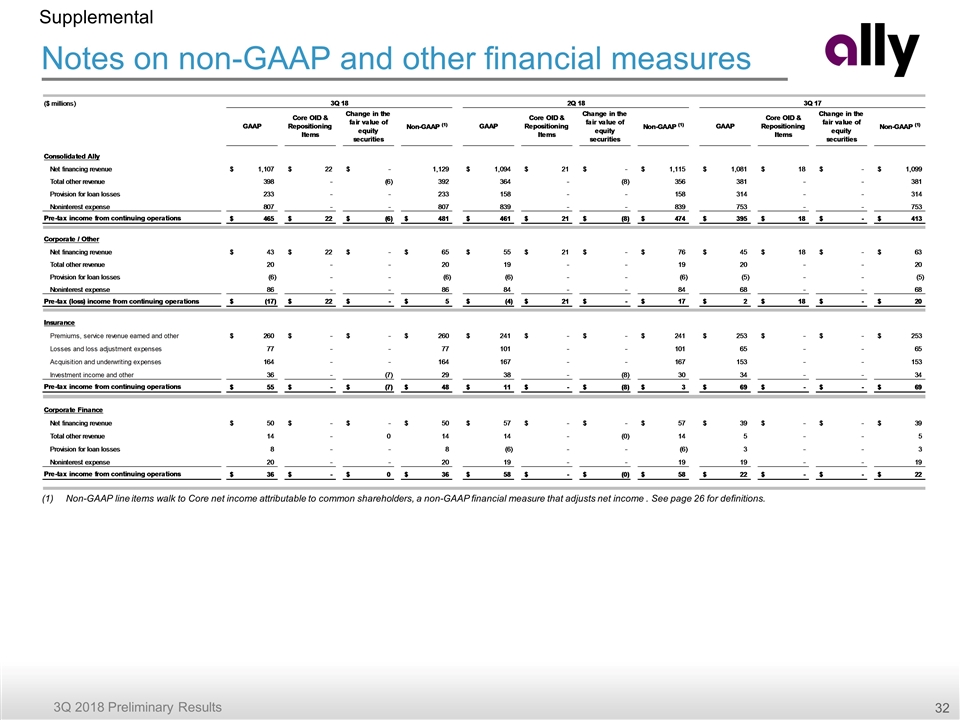
Notes on non-GAAP and other financial measures Supplemental Non-GAAP line items walk to Core net income attributable to common shareholders, a non-GAAP financial measure that adjusts net income . See page 26 for definitions.
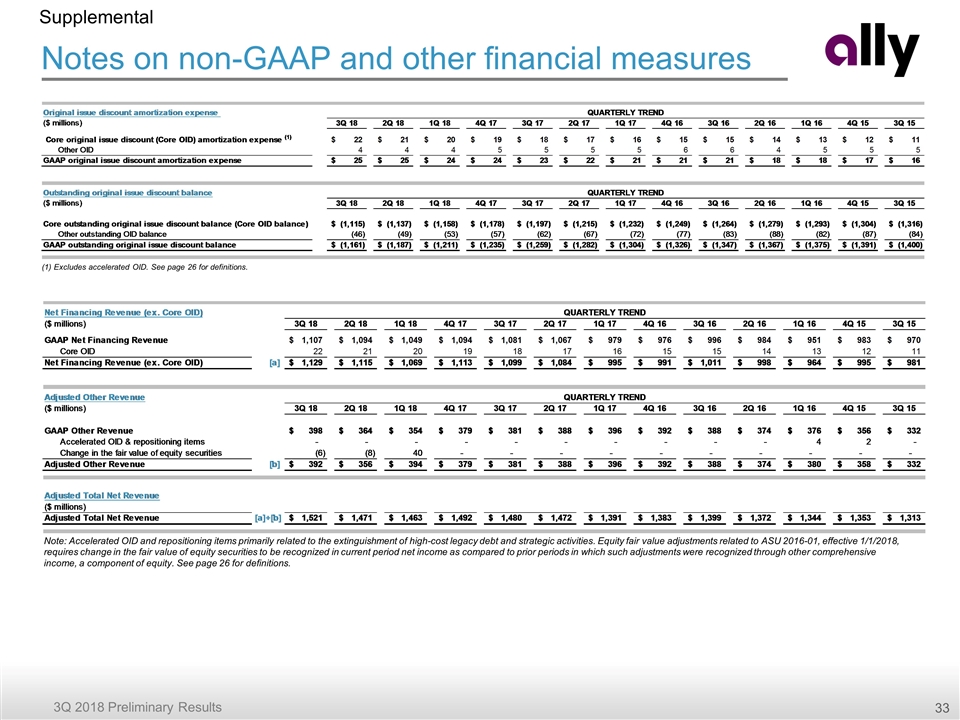
Notes on non-GAAP and other financial measures Supplemental (1) Excludes accelerated OID. See page 26 for definitions. Note: Accelerated OID and repositioning items primarily related to the extinguishment of high-cost legacy debt and strategic activities. Equity fair value adjustments related to ASU 2016-01, effective 1/1/2018, requires change in the fair value of equity securities to be recognized in current period net income as compared to prior periods in which such adjustments were recognized through other comprehensive income, a component of equity. See page 26 for definitions.
































